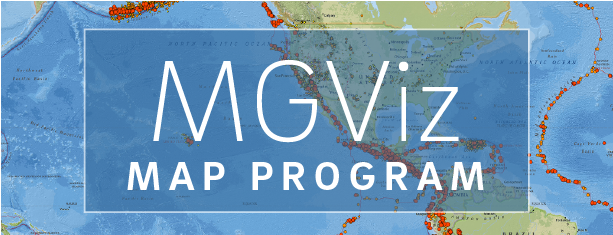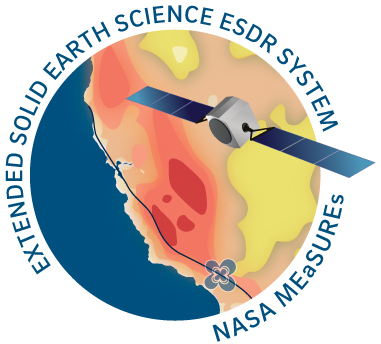Transients - Cascadia ETS Events
05/15/2023: ETS transient product updated for new event 2022/09-2022/11
09/29/2022: ETS transient product updated for three new events (2021-2022)
Download from SOPAC: Transient Product (Username: Anonymous; Password: Your email address)
Download from CDDIS: Transient Product (Register for NASA Earthdata login)
View: Zhen Liu Video
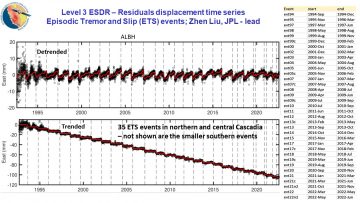
Background
The discovery of slow slip events such as episodic tremor and slip (ETS) in Cascadia margin over the past decades has changed our understanding of tectonic hazards and the earthquake cycle (Dragert et al., 2001; Rogers and Dragert, 2003). Slow slip transients can change stress on the fault interface, trigger earthquake swarms or seismicity (e.g., Segall et al., 2006; Lohman and McGuire, 2007; Fu et al., 2015), and release accumulated elastic strain on the fault interface (e.g., Liu et al., 2015; Dixon et al., 2014). They seem to occur throughout the interseismic period and have now been observed at a number of subduction zones (Beroza and Ide, 2011). As slow slip transient may evolve into catastrophic megathrust earthquakes (Segall and Bradley, 2012), proper detection and characterization of slow slip events is crucial in our understanding of earthquake hazard. Combined with seismic tremor catalog, a high-quality transient catalog enables the investigation of the genesis and mechanism of slow earthquakes.
Our transient product detects and models ETS events in Cascadia since 1993. The PANGA and WCDA continuous GPS networks in Cascadia were the primary source of data until UNAVCO's Plate Boundary Observatory (PBO - now called NOTA, the Network of the Americas) greatly expanded the number and distribution of station from about 2005.
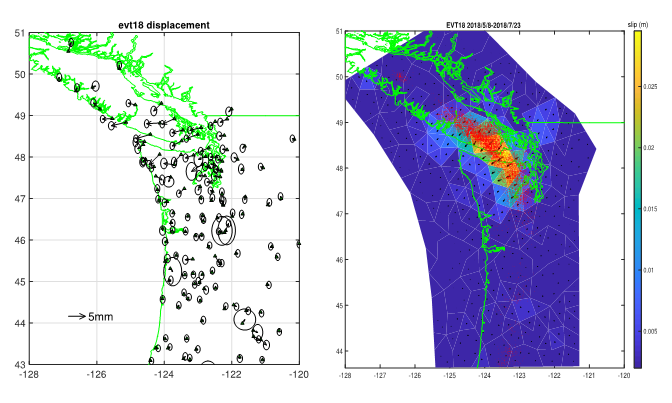
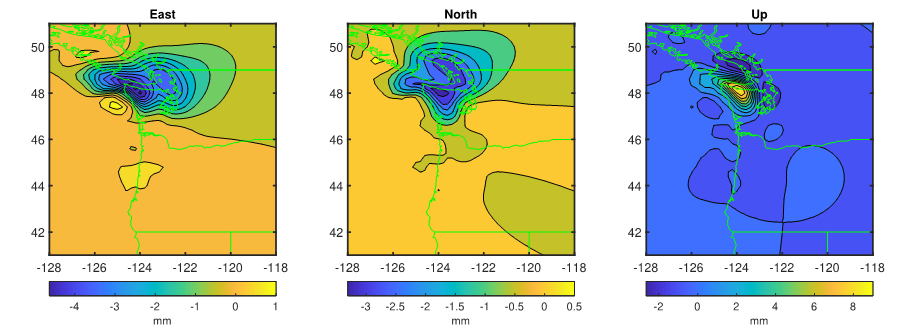
Products
The transient products are contained in a tar file with the name:
ProjectName_YYYYMMDD at the date (YYYYMMDD) of the most recent upload to CDDIS
e.g., CascadiaETS_20210412.tar.gz (“Cascadia” is region; “ETS” is the transient type)
The directory structure for the SOPAC archive is as follows:
Top directory will include:
List of Cascadia ETS transients
A folder for each event, evtYY , e.g.,
Schedule
A new set of displacements will be made available whenever a new transient event is detected and analyzed and/or when newly updated time series solutions warrant the re-analysis. We plan to expand our transient products to other subduction zones beyond Cascadia, such as Japan, New Zealand and Costa Rica, depending on the addition of a sufficient number of stations in these regions.
References
Beroza, G.C. and Ide, S. (2011), Slow earthquakes and nonvolcanic tremor, Annual Review of Earth and Planetary Sciences, 39: 271–296.
Crowell, B., Y. Bock, Z. Liu (2016), Single-station automated detection of transient deformation in GPS time series with the relative strength index: A case study of Cascadian slow-slip, J. Geophys. Res., 121, doi:10.1002/2016JB013542.
Dixon, T. H., Y. Jiang, R. Malservisi, R. McCaffrey, N. Voss, M. Protti, V. Gonzalez (2014), Earthquake and tsunami forecasts: relation of slow slip events to subsequent earthquake rupture, PNAS, 111(48), 17039-17044, www.pnas.org/cgi/doi/10.1073/pnas.1412299111.
Dragert H., K. Wang, T. S. James (2001), A silent slip event on the deeper Cascadia subduction interface. Science, 292(5521), 1525-1528. doi:10.1126/science.1060152
Fu, Y., Z. Liu, J. Freymueller (2015), Spatiotemporal variations of the slow slip event between 2008 and 2013 in the southcentral Alaska subduction zone, Geochemistry, Geophysics, Geosystems, 2450-2461, doi: 10.1002/2015GC005904.
Liu, Z., A. Moore, S. Owen (2015), Recurrent slow slip event reveals the interaction with seismic slow earthquakes and disruption from large earthquake, Geophys. J. Int., 202, 1555-1565, doi: 10.1093/gji/ggv238.
Lohman, R. B., and J. J. McGuire (2007), Earthquake swarms driven by aseismic creep in the Salton Trough, California, J. Geophys. Res., 112, B04405, doi:10.1029/2006JB004596.
Rogers, G. and H. Dragert (2003), Episodic tremor and slip on the Cascadia subduction zone: The chatter of silent slip, Science 300(5627): 1942-1943.
Segall, P., E. Desmarais, D. Shelly, A. Miklius, and P. Cervelli (2006), Earthquakes triggered by silent slip events on Kilauea volcano, Hawaii, Nature, 442, doi:10.1038/nature04938.
Segall, P., and A. M. Bradley (2012), Slow-slip evolves into megathrust earthquakes in 2D numerical simulations, Geophys. Res. Lett., 39, L18308, doi:10.1029/2012GL052811.


